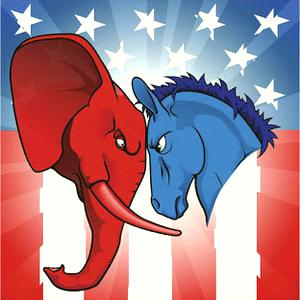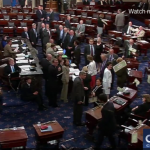It seems that some rock-ribbed Republicans, those who represent the GOP’s grown-ups, are experiencing a transformative phase that has prompted some to consider the creation of a moderate, independent third party to challenge the Republican/Democrat duopoly.
It also seems that the Donald Trump candidacy – and now the erratic Trump presidency – has shaken many GOP establishment folks to their core. They realize that in 2017 the core – the Trump die-hards that the president plays to on a daily basis – are people who are shredding an American democratic system of stability, pragmatism and problem-solving that relies on bipartisan compromise for governing.
Both parties are in denial as independents, including moderates and centrists, have become the largest voting bloc in America – beyond Republicans and Democrats. The Washington gridlock of the past eight years has created a wide swath of voters in the middle who see few redeeming qualities in either party. The extremists and fringe elements on both sides of the aisle are guilty of demanding purity even as their laundry-list agenda does not appeal to mainstream America.
A Gallup poll released earlier this month found that 45 percent of the nation’s voters identify as independents, compared to 28 percent for the Democrats and 25 percent for the Republicans. In a continuing trend, that survey marked the fifth consecutive year in which at least four in 10 American voters identified as independents.
What’s more, in September 2015, just as the presidential race was heating up, a Gallup poll found that 60 percent of Americans said a third major political party is needed because the Republican and Democratic parties “do such a poor job” of representing the American people.
Moderates who lean liberal on some issues and conservative on others have no place to call home. In Washington, they are being squeezed out by both parties as their ranks in Congress amount to a mere fraction of where they stood a few decades ago.
On the Democratic side, Sen. Elizabeth Warren of Massachusetts recently laid down the gauntlet, claiming that the left-wing now serves as the “heart and soul of the Democratic Party.” The leftward lurch among Democrats in response to the Trump presidency features litmus tests, such as the declaration by Sen. Bernie Sanders, a so-called independent, that those who do not favor a government-run health care system for all are should not be welcome in the party.
On the Republican side, staunch GOP standardbearers such as Bill Kristol, David Frum, Sen. Lindsey Graham, Peggy Noonan, Sen. John McCain and a whole host of writers and commentators at traditional conservative publications such as the Wall Street Journal, National Review and Weekly Standard have thoroughly abandoned the “Yea Team” approach. They openly proclaim that Trumpism is antithetical to traditional Republicanism.
On Capitol Hill, Trump treats members of Congress as his minions and attacks fellow Republicans – even Senate Majority Leader Mitch McConnell — on a remarkably vitriolic level. With Trump leading the charge, it appears that numerous House and Senate Republicans could face GOP primary election challenges next year. The same scenario is playing out among the Democratic left as some despise the party’s centrists with as much ferocity as the right-wing GOPers who blast their remaining moderates as Republicans In Name Only (RINOs).
Not surprisingly, those on the left and right fringes – always the loudest voices in the room – drown out the most rational voters in the middle.
This dogmatic hyper-partisanship on both sides, inspired by the elixir of gaining more power by winning more elections, is based on the delusional hope that the United States will one day be led by a monolithic federal government that fully imposes far-right or far-left ideologies. That belief, of course, foolishly belies the central premise that emerges in the voting process every two years: Independents in the middle decide elections.
As the gaping divide between loyal Republicans and Democrats grows, the chances of a new independent party filling that abyss grow day by day.
But the Centrist Project, a group pushing for more independents in Congress, points out that structural barriers foil independent candidates’ ability to compete on an even plain. Burdensome limits to independents gaining ballot access represent one set of hurdles, another is even more basic – state laws that prevent independent voters from participating in primary elections.
So, who initially created, and now protects, these restrictions built into the election system? In a rare show of unity, it is the Democrats and Republicans, of course.









